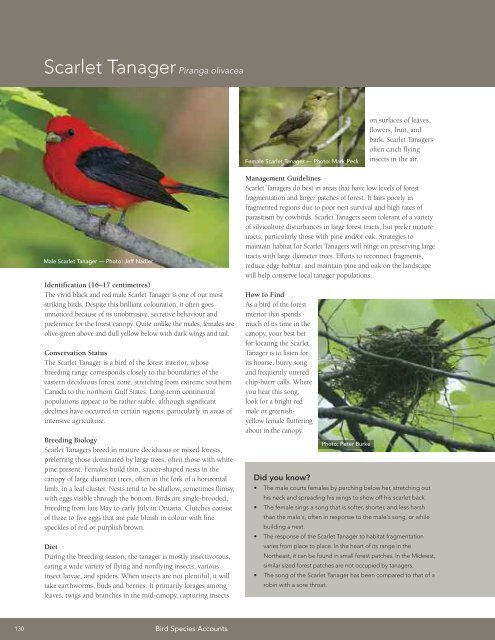A land manager's guide to conserving habitat for forest birds in ...
A land manager's guide to conserving habitat for forest birds in ...
A land manager's guide to conserving habitat for forest birds in ...
Create successful ePaper yourself
Turn your PDF publications into a flip-book with our unique Google optimized e-Paper software.
Scarlet Tanager Piranga olivacea<br />
Female Scarlet Tanager — Pho<strong>to</strong>: Mark Peck<br />
on surfaces of leaves,<br />
flowers, fruit, and<br />
bark. Scarlet Tanagers<br />
often catch fly<strong>in</strong>g<br />
<strong>in</strong>sects <strong>in</strong> the air.<br />
Male Scarlet Tanager — Pho<strong>to</strong>: Jeff Nadler<br />
Identification (16–17 centimetres)<br />
The vivid black and red male Scarlet Tanager is one of our most<br />
strik<strong>in</strong>g <strong>birds</strong>. Despite this brilliant colouration, it often goes<br />
unnoticed because of its unobtrusive, secretive behaviour and<br />
preference <strong>for</strong> the <strong>for</strong>est canopy. Quite unlike the males, females are<br />
olive-green above and dull yellow below with dark w<strong>in</strong>gs and tail.<br />
Conservation Status<br />
The Scarlet Tanager is a bird of the <strong>for</strong>est <strong>in</strong>terior, whose<br />
breed<strong>in</strong>g range corresponds closely <strong>to</strong> the boundaries of the<br />
eastern deciduous <strong>for</strong>est zone, stretch<strong>in</strong>g from extreme southern<br />
Canada <strong>to</strong> the northern Gulf States. Long-term cont<strong>in</strong>ental<br />
populations appear <strong>to</strong> be rather stable, although significant<br />
decl<strong>in</strong>es have occurred <strong>in</strong> certa<strong>in</strong> regions, particularly <strong>in</strong> areas of<br />
<strong>in</strong>tensive agriculture.<br />
Breed<strong>in</strong>g Biology<br />
Scarlet Tanagers breed <strong>in</strong> mature deciduous or mixed <strong>for</strong>ests,<br />
preferr<strong>in</strong>g those dom<strong>in</strong>ated by large trees, often those with white<br />
p<strong>in</strong>e present. Females build th<strong>in</strong>, saucer-shaped nests <strong>in</strong> the<br />
canopy of large diameter trees, often <strong>in</strong> the <strong>for</strong>k of a horizontal<br />
limb, <strong>in</strong> a leaf cluster. Nests tend <strong>to</strong> be shallow, sometimes flimsy,<br />
with eggs visible through the bot<strong>to</strong>m. Birds are s<strong>in</strong>gle-brooded,<br />
breed<strong>in</strong>g from late May <strong>to</strong> early July <strong>in</strong> Ontario. Clutches consist<br />
of three <strong>to</strong> five eggs that are pale bluish <strong>in</strong> colour with f<strong>in</strong>e<br />
speckles of red or purplish brown.<br />
Diet<br />
Dur<strong>in</strong>g the breed<strong>in</strong>g season, the tanager is mostly <strong>in</strong>sectivorous,<br />
eat<strong>in</strong>g a wide variety of fly<strong>in</strong>g and nonfly<strong>in</strong>g <strong>in</strong>sects, various<br />
<strong>in</strong>sect larvae, and spiders. When <strong>in</strong>sects are not plentiful, it will<br />
take earthworms, buds and berries. It primarily <strong>for</strong>ages among<br />
leaves, twigs and branches <strong>in</strong> the mid-canopy, captur<strong>in</strong>g <strong>in</strong>sects<br />
Management Guidel<strong>in</strong>es<br />
Scarlet Tanagers do best <strong>in</strong> areas that have low levels of <strong>for</strong>est<br />
fragmentation and larger patches of <strong>for</strong>est. It fairs poorly <strong>in</strong><br />
fragmented regions due <strong>to</strong> poor nest survival and high rates of<br />
parasitism by cow<strong>birds</strong>. Scarlet Tanagers seem <strong>to</strong>lerant of a variety<br />
of silviculture disturbances <strong>in</strong> large <strong>for</strong>est tracts, but prefer mature<br />
tracts, particularly those with p<strong>in</strong>e and/or oak. Strategies <strong>to</strong><br />
ma<strong>in</strong>ta<strong>in</strong> <strong>habitat</strong> <strong>for</strong> Scarlet Tanagers will h<strong>in</strong>ge on preserv<strong>in</strong>g large<br />
tracts with large diameter trees. Ef<strong>for</strong>ts <strong>to</strong> reconnect fragments,<br />
reduce edge <strong>habitat</strong>, and ma<strong>in</strong>ta<strong>in</strong> p<strong>in</strong>e and oak on the <strong>land</strong>scape<br />
will help conserve local tanager populations.<br />
How <strong>to</strong> F<strong>in</strong>d<br />
As a bird of the <strong>for</strong>est<br />
<strong>in</strong>terior that spends<br />
much of its time <strong>in</strong> the<br />
canopy, your best bet<br />
<strong>for</strong> locat<strong>in</strong>g the Scarlet<br />
Tanager is <strong>to</strong> listen <strong>for</strong><br />
its hoarse, burry song<br />
and frequently uttered<br />
chip-burrr calls. Where<br />
you hear this song,<br />
look <strong>for</strong> a bright red<br />
male or greenishyellow<br />
female flutter<strong>in</strong>g<br />
about <strong>in</strong> the canopy.<br />
Did you know?<br />
Pho<strong>to</strong>: Peter Burke<br />
• The male courts females by perch<strong>in</strong>g below her, stretch<strong>in</strong>g out<br />
his neck and spread<strong>in</strong>g his w<strong>in</strong>gs <strong>to</strong> show off his scarlet back<br />
• The female s<strong>in</strong>gs a song that is softer, shorter, and less harsh<br />
than the male’s, often <strong>in</strong> response <strong>to</strong> the male’s song, or while<br />
build<strong>in</strong>g a nest.<br />
• The response of the Scarlet Tanager <strong>to</strong> <strong>habitat</strong> fragmentation<br />
varies from place <strong>to</strong> place. In the heart of its range <strong>in</strong> the<br />
Northeast, it can be found <strong>in</strong> small <strong>for</strong>est patches. In the Midwest,<br />
similar sized <strong>for</strong>est patches are not occupied by tanagers.<br />
• The song of the Scarlet Tanager has been compared <strong>to</strong> that of a<br />
rob<strong>in</strong> with a sore throat.<br />
130<br />
Bird Species Accounts

















